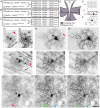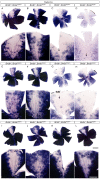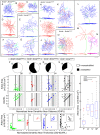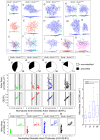Genetic interactions between Brn3 transcription factors in retinal ganglion cell type specification
- PMID: 24116103
- PMCID: PMC3792956
- DOI: 10.1371/journal.pone.0076347
Genetic interactions between Brn3 transcription factors in retinal ganglion cell type specification
Abstract
Background: Visual information is conveyed from the retina to the brain via 15-20 Retinal Ganglion Cell (RGC) types. The developmental mechanisms by which RGC types acquire their distinct molecular, morphological, physiological and circuit properties are essentially unknown, but may involve combinatorial transcriptional regulation. Brn3 transcription factors are expressed in RGCs from early developmental stages, and are restricted in adults to distinct, partially overlapping populations of RGC types. Previously, we described cell autonomous effects of Brn3b (Pou4f2) and Brn3a (Pou4f1) on RGC axon and dendrites development.
Methods and findings: We now have investigated genetic interactions between Brn3 transcription factors with respect to RGC development, by crossing conventional knock-out alleles of each Brn3 gene with conditional knock-in reporter alleles of a second Brn3 gene, and analyzing the effects of single or double Brn3 knockouts on RGC survival and morphology. We find that Brn3b loss results in axon defects and dendritic arbor area and lamination defects in Brn3a positive RGCs, and selectively affects survival and morphology of specific Brn3c (Pou4f3) positive RGC types. Brn3a and Brn3b interact synergistically to control RGC numbers. Melanopsin positive ipRGCs are resistant to combined Brn3 loss but are under the transcriptional control of Isl1, expanding the combinatorial code of RGC specification.
Conclusions: Taken together these results complete our knowledge on the mechanisms of transcriptional control of RGC type specification. They demonstrate that Brn3b is required for the correct development of more RGC cell types than suggested by its expression pattern in the adult, but that several cell types, including some Brn3a, Brn3c or Melanopsin positive RGCs are Brn3b independent.
Conflict of interest statement
Figures









Similar articles
-
Differential expression of Brn3 transcription factors in intrinsically photosensitive retinal ganglion cells in mouse.J Comp Neurol. 2012 Mar 1;520(4):742-55. doi: 10.1002/cne.22765. J Comp Neurol. 2012. PMID: 21935940
-
Whole number, distribution and co-expression of brn3 transcription factors in retinal ganglion cells of adult albino and pigmented rats.PLoS One. 2012;7(11):e49830. doi: 10.1371/journal.pone.0049830. Epub 2012 Nov 16. PLoS One. 2012. PMID: 23166779 Free PMC article.
-
Morphologies of mouse retinal ganglion cells expressing transcription factors Brn3a, Brn3b, and Brn3c: analysis of wild type and mutant cells using genetically-directed sparse labeling.Vision Res. 2011 Jan 28;51(2):269-79. doi: 10.1016/j.visres.2010.08.039. Epub 2010 Sep 6. Vision Res. 2011. PMID: 20826176 Free PMC article.
-
A gene regulatory hierarchy for retinal ganglion cell specification and differentiation.Semin Cell Dev Biol. 2004 Feb;15(1):115-23. doi: 10.1016/j.semcdb.2003.09.009. Semin Cell Dev Biol. 2004. PMID: 15036214 Review.
-
Genetic control of retinal ganglion cell genesis.Cell Mol Life Sci. 2021 May;78(9):4417-4433. doi: 10.1007/s00018-021-03814-w. Epub 2021 Mar 29. Cell Mol Life Sci. 2021. PMID: 33782712 Free PMC article. Review.
Cited by
-
The Transcription Factor Prdm16 Marks a Single Retinal Ganglion Cell Subtype in the Mouse Retina.Invest Ophthalmol Vis Sci. 2017 Oct 1;58(12):5421-5433. doi: 10.1167/iovs.17-22442. Invest Ophthalmol Vis Sci. 2017. PMID: 29053761 Free PMC article.
-
Generation of highly enriched populations of optic vesicle-like retinal cells from human pluripotent stem cells.Curr Protoc Stem Cell Biol. 2015 Feb 2;32:1H.8.1-1H.8.20. doi: 10.1002/9780470151808.sc01h08s32. Curr Protoc Stem Cell Biol. 2015. PMID: 25640818 Free PMC article.
-
Reconnecting Eye to Brain.J Neurosci. 2016 Oct 19;36(42):10707-10722. doi: 10.1523/JNEUROSCI.1711-16.2016. J Neurosci. 2016. PMID: 27798125 Free PMC article. Review.
-
Wiring the Binocular Visual Pathways.Int J Mol Sci. 2019 Jul 4;20(13):3282. doi: 10.3390/ijms20133282. Int J Mol Sci. 2019. PMID: 31277365 Free PMC article. Review.
-
Brn3a and Brn3b knockout mice display unvaried retinal fine structure despite major morphological and numerical alterations of ganglion cells.J Comp Neurol. 2019 Jan 1;527(1):187-211. doi: 10.1002/cne.24072. Epub 2016 Jul 29. J Comp Neurol. 2019. PMID: 27391320 Free PMC article.
References
-
- Levick WR (1975) Form and function of cat retinal ganglion cells. Nature 254: 659–662. - PubMed
-
- Masland RH (2001) Neuronal diversity in the retina. Curr Opin Neurobiol 11: 431–436. - PubMed
-
- Troy JB, Shou T (2002) The receptive fields of cat retinal ganglion cells in physiological and pathological states: where we are after half a century of research. Prog Retin Eye Res 21: 263–302. - PubMed
-
- Wassle H (2004) Parallel processing in the mammalian retina. Nat Rev Neurosci 5: 747–757. - PubMed
-
- Field GD, Chichilnisky EJ (2007) Information processing in the primate retina: circuitry and coding. Annu Rev Neurosci 30: 1–30. - PubMed
Publication types
MeSH terms
Substances
Grants and funding
LinkOut - more resources
Full Text Sources
Other Literature Sources
Molecular Biology Databases
Miscellaneous

